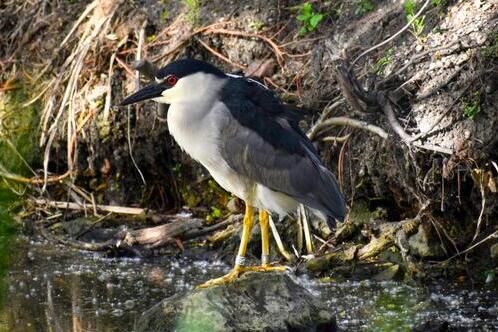Conservation project tracks behavior, migration of Chicago's endangered heron

Among the snowbirds returning north for the summer, A24 is special. For one thing, A24 is an actual bird: a Black-crowned night heron, to be exact. And it has just returned to Chicago to join hundreds of its kind nesting near Lake Michigan. But unlike the human snowbirds that share A24’s migratory habits, this bird is helping to inform conservation efforts in the city and far beyond.
A24 and its heron family need all the help they can get. These wading birds are declining across much of their historic range in the U.S., and are listed as a special-status species in 11 states. University of Illinois Urbana-Champaign professor Mike Ward says the number of breeding colonies has dropped dramatically over the last 30 years as critical wetland habitats have been destroyed or degraded by agricultural and urban development.
“Continued anthropogenic disturbance has caused long-term colonies to be abandoned,” added Brad Semel, Illinois Department of Natural Resources endangered species recovery specialist. “This has been particularly true in Illinois, where the species has been listed as state-endangered since 1977. The single remaining major rookery is located at the Lincoln Park Zoo near downtown Chicago.”
Since the birds’ arrival in the Lincoln Park area in 2007, biologists with the zoo’s Urban Wildlife Institute have monitored the colony closely. They say it appears to be flourishing despite the inherent risks associated with nesting in a highly urbanized area. Henry Adams, UWI’s wildlife management coordinator, said over 300 breeding pairs fledged more than 400 chicks in 2023.
While Black-crowned night herons have a long history of urbanizing in North America, researchers don't know exactly why this colony has been so successful in Chicago. They’re hoping to learn more about the herons’ habits — what they eat and where they spend time in the city — to help maintain that success. A big part of sustaining the colony’s health is ensuring high-quality habitat beyond city limits, along the birds’ annual migratory route. But until recently, researchers could only guess where they went.
That’s where A24 comes in.
Researchers at U. of I. teamed up with scientists from Lincoln Park Zoo and IDNR to unlock the secrets of the herons’ success in Chicago and beyond, leading to better-informed conservation strategies for the species. During the project’s pilot season in 2023, the team attached seven satellite transmitter “backpacks” onto adult and juvenile birds, including an individual dubbed A24, and banded an additional 20+ herons born that year. The transmitters collect GPS points of each tagged bird’s location every hour.
“So far, these transmitters have shown us that birds are utilizing a wide variety of natural and human-made water bodies across the cityscape, some of which are hydrologically influenced by Lake Michigan while others are managed by state and public agencies,” said Ward, Stuart L. and Nancy J. Levenick Chair in Sustainability in the Department of Natural Resources and Environmental Sciences (NRES), part of the College of Agricultural, Consumer and Environmental Sciences (ACES) at U. of I. “We hope to triple the number of tagged birds in 2024, significantly increasing the scale of this program and enhancing our knowledge of the behavior and ecology of the heron in the Great Lakes region and along their migratory routes.”
Data collected from birds tagged during the 2023 breeding season are starting to provide some fascinating insights.
“A24 went on a particularly interesting journey after leaving Chicago in late July 2023,” said Sarah Slayton, an NRES master’s student working with Ward. “After the bird completed the breeding season, it surprisingly departed to the north and ended up spending several months fueling up for migration in Green Bay, Wisconsin. In mid-September it began its weeklong southern flight down to Florida, ultimately settling on the Seminole Tribe of Florida’s Brighton Reservation in Glades County.”
The selection of the Brighton Seminole Reservation was a smart move for A24, as there are extensive ongoing natural resource management efforts on the Reservation. The Seminole Tribe of Florida lands span more than 90,000 acres in one of the nation’s most sensitive, ecologically important areas of the Everglades.
“The Tribe holds a unique relationship with the environment, where connections with the landscape and ecological communities are culturally significant. Diverse habitats and wildlife have sustained the Tribal communities throughout Seminole history by providing food, shelter, and medicinal resources,” said Kari Eckel, the Tribe’s environmental science manager. “The Seminole Tribe continues to take pride in managing natural resources for not only the benefit of Tribal communities, but in support of the sensitive wildlife and ecological communities which comprise the greater Everglades region.”
A24 has just returned to Chicago after its arduous 1,500-mile journey from the Seminole wetlands. The research team will continue to analyze its movement data to identify and evaluate the quality of the habitats it selects throughout the year.
“This project really illustrates the coordination needed to conserve our migratory birds,” Ward said. “Whether it is volunteering to help clean up a wetland, leaving an area on your property for wildlife habitat, reducing the use of pesticides, or contributing to conservation organizations, we all can help protect our migratory birds and ultimately our environment.”
This research is made possible with the support of the Bird Conservation Network, Chicago Black-crowned Night-Heron Project, Chicago Park District, Illinois Department of Natural Resources, Illinois Audubon Society, Lincoln Park Zoo, and the Seminole Tribe of Florida, Environmental Resources Department.